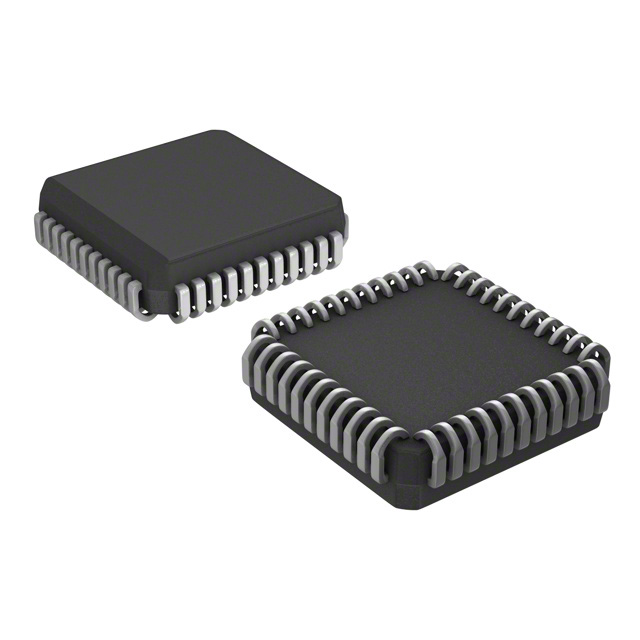AT80C51RA2-SLRUM
Product Overview
Category
AT80C51RA2-SLRUM belongs to the category of microcontrollers.
Use
It is primarily used for embedded systems and various applications that require a microcontroller with advanced features.
Characteristics
- High-performance 8-bit microcontroller
- Low power consumption
- Enhanced peripheral set
- Large memory capacity
- Fast execution speed
Package
AT80C51RA2-SLRUM comes in a compact and durable package, suitable for surface mount technology (SMT) applications.
Essence
The essence of AT80C51RA2-SLRUM lies in its ability to provide efficient processing capabilities and versatile functionality for a wide range of applications.
Packaging/Quantity
The product is typically packaged in reels or trays, depending on the manufacturer's specifications. The quantity per package may vary, but it is commonly available in bulk quantities for industrial production.
Specifications
- Architecture: 8-bit
- CPU Speed: Up to 40 MHz
- Program Memory Size: 64 KB
- Data Memory Size: 2 KB
- Number of I/O Pins: 32
- Operating Voltage Range: 2.7V to 5.5V
- Communication Interfaces: UART, SPI, I2C
- Timers/Counters: Multiple timers/counters available
- Analog-to-Digital Converter (ADC): Integrated ADC module
- Interrupt Sources: External and internal interrupt sources
Detailed Pin Configuration
The pin configuration of AT80C51RA2-SLRUM is as follows:
- VCC - Power supply voltage
- GND - Ground
- P0.0 to P0.7 - General-purpose I/O pins
- P1.0 to P1.7 - General-purpose I/O pins
- P2.0 to P2.7 - General-purpose I/O pins
- P3.0 to P3.7 - General-purpose I/O pins
- RST - Reset pin
- XTAL1 - Crystal oscillator input
- XTAL2 - Crystal oscillator output
Functional Features
- High-speed processing capabilities
- Enhanced peripheral set for versatile applications
- Efficient power management for low power consumption
- Integrated analog-to-digital converter for sensor interfacing
- Multiple communication interfaces for data exchange
- Flexible timer/counters for precise timing operations
- Extensive interrupt system for event-driven programming
Advantages and Disadvantages
Advantages
- High-performance microcontroller suitable for demanding applications
- Large memory capacity allows for complex program execution
- Versatile peripheral set enables integration with various devices
- Low power consumption extends battery life in portable applications
- Fast execution speed enhances overall system performance
Disadvantages
- Limited availability of alternative models from different manufacturers
- Relatively higher cost compared to some other microcontrollers in the market
- Steeper learning curve for beginners due to its advanced features
Working Principles
AT80C51RA2-SLRUM operates based on the principles of a typical 8-bit microcontroller. It executes instructions stored in its program memory, interacts with peripherals through I/O pins, and responds to external events through interrupts. The central processing unit (CPU) fetches instructions, decodes them, and performs the necessary operations. The microcontroller's internal architecture and specialized modules enable it to handle various tasks efficiently.
Detailed Application Field Plans
AT80C51RA2-SLRUM finds applications in diverse fields, including but not limited to: - Industrial automation - Consumer electronics - Automotive systems - Medical devices - Internet of Things (IoT) applications - Robotics - Home automation
Its high-performance capabilities, extensive peripheral set, and large memory capacity make it suitable for complex applications that require precise control, data processing, and communication.
Detailed and Complete Alternative Models
While AT80C51RA2-SLRUM is a reliable microcontroller, there are alternative models available in the market that offer similar functionalities. Some notable alternatives include: - ATmega328P by Microchip Technology - PIC18F4550 by Microchip Technology - STM32F103C8T6 by STMicroelectronics - MSP430G2553 by Texas Instruments
These alternative models provide comparable features and performance, allowing developers to choose the most suitable microcontroller for their specific application requirements.
Word count: 589 words
Senaraikan 10 soalan dan jawapan biasa yang berkaitan dengan aplikasi AT80C51RA2-SLRUM dalam penyelesaian teknikal
Sure! Here are 10 common questions and answers related to the application of AT80C51RA2-SLRUM in technical solutions:
Q: What is the AT80C51RA2-SLRUM microcontroller used for? A: The AT80C51RA2-SLRUM is a microcontroller commonly used in various technical solutions, such as embedded systems, industrial automation, consumer electronics, and IoT devices.
Q: What is the operating voltage range of the AT80C51RA2-SLRUM? A: The AT80C51RA2-SLRUM operates within a voltage range of 2.7V to 5.5V.
Q: How much flash memory does the AT80C51RA2-SLRUM have? A: The AT80C51RA2-SLRUM has 64KB of on-chip flash memory for program storage.
Q: Can I expand the memory of the AT80C51RA2-SLRUM? A: Yes, the AT80C51RA2-SLRUM supports external memory expansion through its address and data bus.
Q: What peripherals are available on the AT80C51RA2-SLRUM? A: The AT80C51RA2-SLRUM includes various peripherals like UART, SPI, I2C, timers/counters, PWM, ADC, and GPIO pins.
Q: Does the AT80C51RA2-SLRUM support interrupts? A: Yes, the AT80C51RA2-SLRUM supports both external and internal interrupts, allowing efficient handling of events and real-time tasks.
Q: Can I communicate with other devices using the AT80C51RA2-SLRUM? A: Yes, the AT80C51RA2-SLRUM supports various communication protocols like UART, SPI, and I2C, enabling seamless integration with other devices.
Q: What programming language can I use to program the AT80C51RA2-SLRUM? A: The AT80C51RA2-SLRUM can be programmed using assembly language or high-level languages like C or C++.
Q: Is the AT80C51RA2-SLRUM suitable for low-power applications? A: Yes, the AT80C51RA2-SLRUM offers power-saving features like multiple sleep modes and idle mode, making it suitable for low-power applications.
Q: Can I debug and program the AT80C51RA2-SLRUM using a development tool? A: Yes, the AT80C51RA2-SLRUM is compatible with various development tools, such as in-circuit emulators (ICE) and integrated development environments (IDEs), which provide debugging and programming capabilities.
Please note that these answers are general and may vary depending on the specific implementation and requirements of your technical solution.


